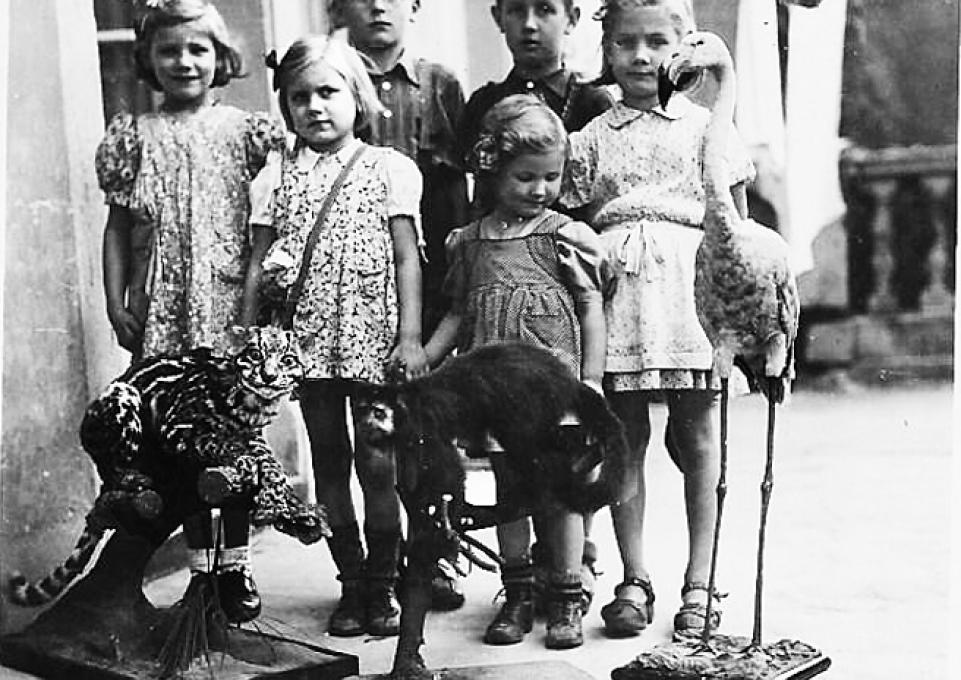
Skin, Ann Colley, SUNY Distinguished Professor of English at Buffalo State, suggests, can be thought of as that which simultaneously identifies, protects, and exposes. It’s also a kind of text, a surface that can be written on and read. Through the sense of touch, skin enables encounters with others.
 Colley continues her exploration of the Victorian era in her most recent book, Wild Animal Skins in Victorian Britain: Zoos, Collections, Portraits, and Maps. Her interest in nineteenth-century Britain is rooted in her own childhood in Lancashire, England. There she was influenced by aspects of the Victorian era that persisted well into the twentieth century. One such aspect—exhibiting taxidermy specimens of animals—is represented in her book by a photograph of a childhood friend. The little girl is posing not only with other children but also with several stuffed animals: a wildcat, a flamingo, and a monkey.
Colley continues her exploration of the Victorian era in her most recent book, Wild Animal Skins in Victorian Britain: Zoos, Collections, Portraits, and Maps. Her interest in nineteenth-century Britain is rooted in her own childhood in Lancashire, England. There she was influenced by aspects of the Victorian era that persisted well into the twentieth century. One such aspect—exhibiting taxidermy specimens of animals—is represented in her book by a photograph of a childhood friend. The little girl is posing not only with other children but also with several stuffed animals: a wildcat, a flamingo, and a monkey.
“My interest in this topic probably has less to do with my interest in Victorian culture and more to do with my fascination with wild animals,” said Colley. “When I travel, I find that encountering the native birds and animals enables me to fully experience the sense of being elsewhere.”
In Wild Animal Skins in Victorian Britain, Colley contemplates the Victorians’ passion for bringing creatures from all over the world back to Britain. Some were live—zoos were springing up all over England during the 1800s—but the logistics of transporting live animals were daunting. “Elephants fell overboard,” said Colley. “And you can imagine the challenges of shipping a live giraffe.”
So bringing animal skins home from the outposts of the global British Empire became commonplace. Although the practice tends to provoke indignation, even outrage, in twenty-first-century America, Colley points out that the cultural climate in nineteenth-century Britain was very different. “At the time, there was a rage for classifying,” she said, “and there was a sense of plenty, with little thought of extinction.” The wealthy and the working class shared a fascination with natural history.
Colley’s book explores not just the collection and display of skins but also the way Victorians reacted to skins both stuffed and living. “In a culture reeling from Darwin’s Origin of the Species,” she writes, “…visitors to Victorian zoos…would have been anxious about the permeable boundaries separating man from beast.”
Colley also notes the importance of the sense of touch, writing “Skin opens our bodies to other bodies through touch.”
Using contemporary thoughts about skin, Colley considers the Victorian impulse to reach through a zoo’s bars to touch captive animals. She also notes that the desire to touch live animals remains alive and well; she recalls waiting in line to pet a cheetah while traveling in South Africa.
Colley’s interest in the Victorian worldview does not preclude her own distaste for some of her findings. Not all animals were hunted and killed to promote the study of natural history. Hunting trophies were mounted on walls, and birds were killed so their feathers could adorn ladies’ hats. Her own love for animals made research challenging at times; for example, Alfred Russell Wallace, who formulated the theory of evolution, studied orangutans, and he wrote in great, sometimes disturbing, detail about the killing of these animals as well as the difficulties he had removing their skins.
Finally, however, Colley’s primary interest lies not in the historical facts of collection, transportation, exploration, and taxidermy but in the Victorian fascination with skin. Understanding skin as identity, barrier, memory, and connection reveals something of their culture as well as of our own.
